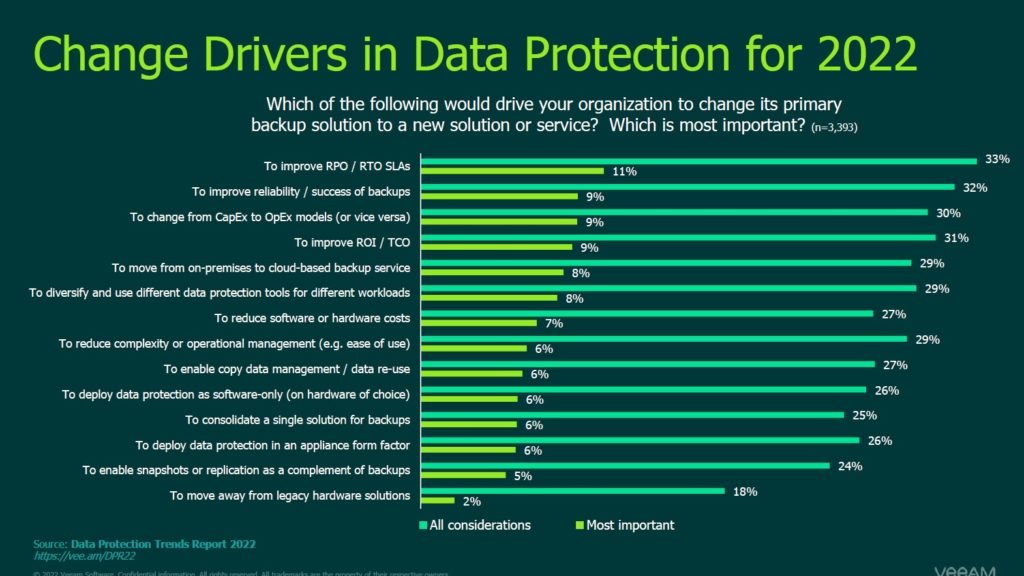Organisations pursuing a digital strategy will, at some point in the journey, need to address the issue of whether current, aka legacy systems and processes, is getting in the way of transformation journeys.
Arguably one of the more important considerations of any modernisation, be it infrastructure, applications, or processes is ensuring data remains protected and secured regardless of the strategy taken.
Change drivers
Notable in the annual Veeam 2022 Data Protection report of the top change drivers in data protection for 2022 is the placement of “moving away from legacy solutions” to the bottom of importance (2%).

Dave Russell, vice president of enterprise strategy at Veeam, says this is not indicative of any bias towards legacy hardware. “It's just that pain point is not enough of an issue for them to change, meaning it could be a concern for them, but it's just not overwhelming. At least not enough of an issue to trigger swapping out solutions,” he continued.
Russell reminds us that reliable, successful backups matter because this is the only way you can recover! Fair enough.
He also made a point to draw attention to a 5.9% (on average) increase in data protection budgets. For Russell, this is notable if you consider that IDC believes overall IT budgets will grow at under 3%.
He opined that this is so between 2020 and 2021, organisations have been moving to the cloud (from on-premises). “Now organisations are catching up, realising that they need to ensure that they can properly protect this (data in the cloud), especially in light of cyber threats, including ransomware,” posited Russell.
Gaps exist
An 'Availability Gap' is the operational gap that exists between user demand for IT services and the services IT is realistically able to deliver on-demand and in real-time.
Alarmingly, participants in the 2022 Veeam study acknowledged both the availability gap (90%) and the protection gap (89%). On availability, Russell interpreted this as respondents believing they will not be able to meet the recovery expectations of their organisation.
On top of data protection, he read this as 90% do not expect they will be able to recover their data. He put a slightly kinder spin on the data suggesting that maybe what respondents were alluding to was not being able to get back the data ‘fast enough’ or they will ‘lose more data than the organisation thinks they will.’
“That shows even in this time frame of right now 2022, we've tried to make so many improvements and do so many things in terms of superior infrastructure, redundant components, we still have a real challenge,” posited Russell.
Click on the PodChat player and listen to Russell share in greater detail his views on the questions below:
Click on the PodChat player to Russell’s candid responses on the following questions:
- Why do you think respondents to the Veeam survey did not deem moving away from legacy hardware solutions as an important driver in their data protection strategies?
- The Veeam report revealed a data protection gap of 40% indicating inadequate backup or failure to meet SLAs as the top challenge in 2021. Is this because IT is too complex to protect systems, including virtualized containers and Shadow IT?
- Do the many different types of outages, be they infrastructure, application, servers or even cybersecurity incidents, can this be attributed to the increasing use of complex heterogeneous systems including on-premises data centres, hybrid and multi-cloud?
- We understand that there has been a noticeable increase in ransomware attacks since the pandemic started. What is the average duration of a ransomware attack from awareness to resolution? And is the resolution veering towards paying the ransom?
- Among the many backup approaches – point-in-time, full, differential, incremental and continuous backups, are backup strategies today changing as companies opt to backup to the cloud?
- Would artificial intelligence in backup narrow the data protection gap and reduce failed recoveries?
- In terms of Veeam’s data protection offering, to what extent are automation technologies being used to improve overall outcome and speed?





